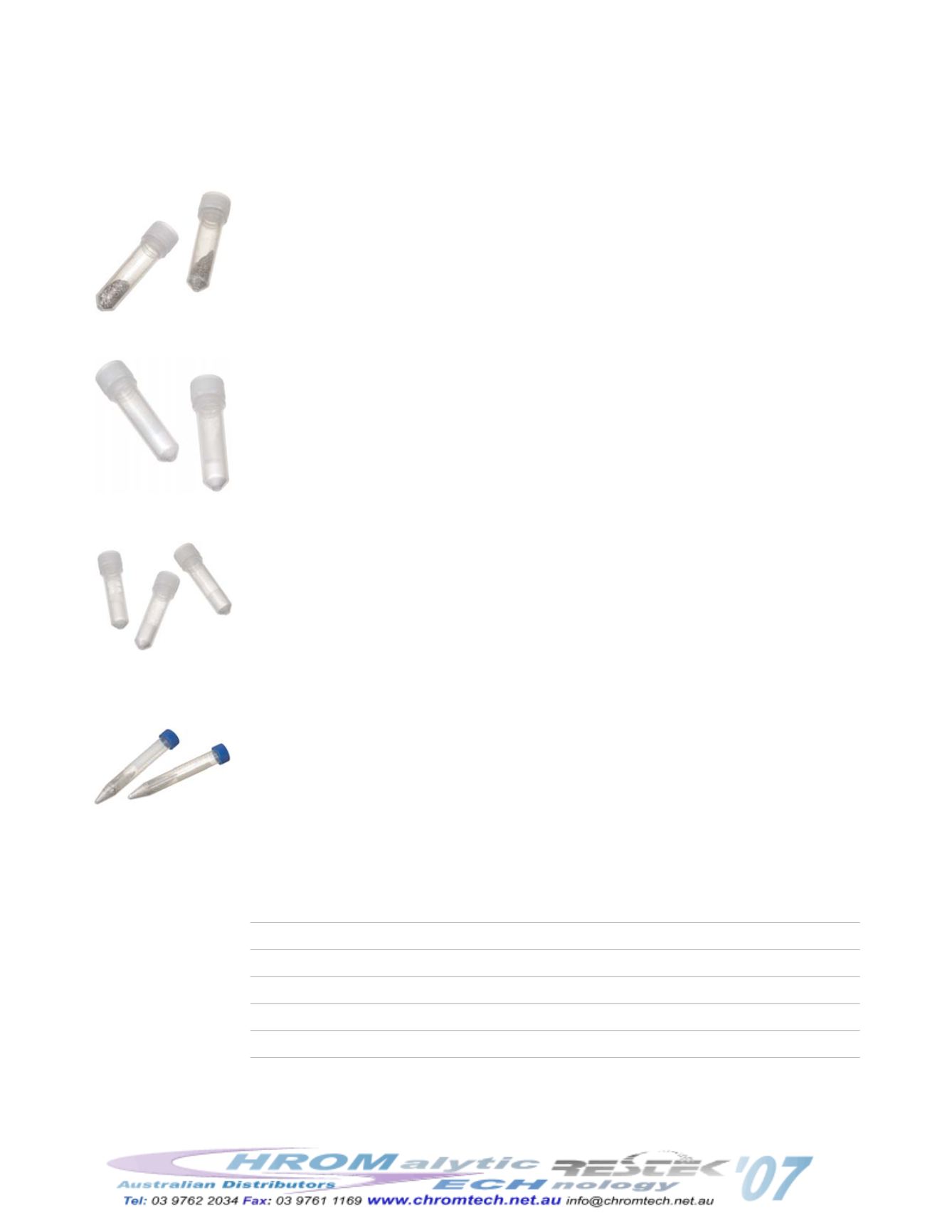

•
18
•
2007.01
Faster Extraction and Cleanup of Pesticide Residue Samples
With QuEChERS Products
By Lydia Nolan, Innovations Chemist
QuEChERS SPE Cartridges
SPE Cartridge
qty.
cat#
price
QuEChERS SPE 2mL Micro-Centrifuge Cartridge
Packed with 150mg Magnesium Sulfate and 50mg PSA
100-pk.
26124
$115
QuEChERS SPE 2mL Micro-Centrifuge Cartridge
Packed with 150mg Magnesium Sulfate, 50mg PSA, and 50mg Graphitized Carbon
100-pk.
26123
$130
QuEChERS SPE 2mL Micro-Centrifuge Cartridge
Packed with 150mg Magnesium Sulfate, 50mg PSA, and 50mg C18
100-pk.
26125
$120
QuEChERS SPE 15mL Centrifuge Cartridge
Packed with 900mg Magnesium Sulfate, 300mg PSA, and 150mg Graphitized Carbon
50-pk.
26126
$175
QuEChERS SPE 6mL SPE Cartridge
Packed with 200mg Graphitized Carbon and 400mg PSA, Teflon
®
Frits
30-pk.
26127
$145
QuEChERS SPE 6mL SPE Cartridge
Packed with 250mg Graphitized Carbon and 500mg PSA, Teflon
®
Frits
30-pk.
26128
$118
QuEChERS SPE 6mL SPE Cartridge
Packed with 500mg Graphitized Carbon and 500mg PSA, Teflon
®
Frits
30-pk.
26129
$128
• Fast, simple sample cleanup.
• Variety of formats, to meet all needs.
• Custom products prepared on request.
Qu
ick,
E
asy,
Ch
eap,
E
ffective,
R
ugged, and
S
afe, the QuEChERS (“catchers”) method is based on work
done and published by the US Department of Agriculture Eastern Regional Research Center in
Wyndmoor, PA.
1
Researchers there were looking for a simple, effective, and inexpensive way to extract and
clean pesticide residues from the many varied sample matrices with which they routinely worked. They
had been using the Modified Luke Extraction Method, which is highly effective and rugged, but is both
labor and glassware intensive, leading to a relatively high cost per sample. Solid phase extraction also had
been effective, but the complex matrices the investigators were dealing with required multiple individual
cartridges and packings to remove the many classes of interferences, adding costs and complexity to the
process. A new method would have to remove sugars, lipids, organic acids, sterols, proteins, pigments and
excess water, any of which often are present, but still be easy to use and inexpensive.
The researchers developed a simple two-step procedure. First, the homogenized samples are extracted and
partitioned, using an organic solvent and salt solution. Then, the supernatant is further extracted and
cleaned, using a dispersive SPE technique. Multiple adsorbents are placed in a centrifuge tube, along with
the 1mL of organic solvent and the extracted residues partitioned from step 1. The contents are thor-
oughly mixed, then centrifuged, producing a clean extract ready for a variety of GC or HPLC analytical
techniques.
2
Validation and proficiency data for the QuEChERS method are available for a wide variety
of pesticides in several common food matrices at
www.quechers.comUsing the dispersive SPE approach, the quantity and type of adsorbents, as well as the pH and polarity of
the solvent, can be easily adjusted for differing matrix interferences and “difficult” analytes. Results from
this approach have been verified and modified at several USDA and Food and Drug Administration labs,
and the method now is widely accepted for many types of pesticide residue samples.
Commercially available products make this approach even
simpler.Weoffer QuEChERS extraction prod-
ucts in a variety of standard sizes and formats. The centrifuge tube format, available in 2mL and 15mL
sizes, contains magnesium sulfate (to partition water from organic solvent) and PSA* adsorbent (to
remove sugars and fatty acids), with or without graphitized carbon (to remove pigments and sterols) or
C18 packing (to remove nonpolar interferences). The PSA and graphitized carbon packings also are avail-
able in a 6mL packed bed SPE cartridge, with Teflon® frits, for whenever a standard SPE format is pre-
ferred. Custom products are available by quote request. If you are frustrated by the time and cost involved
with your current approach to pesticide sample cleanup, we suggest you try this simple and economical
new method.
*PSA – primary and secondary amine exchange material
References
1. Anastassiades, M., S.J.
Lehotay, D. Stajnbaher, F.J.
Schenck,
Fast and Easy
Multiresidue Method
Employing Acetonitrile
Extraction/Partitioning and
“Dispersive Solid-Phase
Extraction” for the
Determination of Pesticide
Residues in Produce
, J AOAC
International, 2003, vol 86 no
22, pp 412-431.
2. Schenck, F.J.,
SPE Cleanup and
the Analysis of PPB Levels of
Pesticides in Fruits and
Vegetables
. Florida Pesticide
Residue Workshop, 2002.
References not available from
Restek.
cat. # 26123
cat. # 26124
cat. # 26125
cat. # 26126











